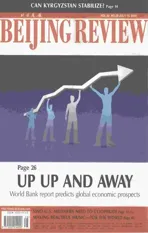BUSINESS MARKET WATCH
2010-09-12HUYUE
BUSINESS MARKET WATCH
OPINION
Fiscal Pressure Is On
In the frst half of 2012, China’s GDP growth rate slumped to 7.8 percent. For the government, it also means a slowdown in the growth of fscal and tax revenue.
According to the National Bureau of Statistics, in the first half of 2012, fiscal revenue was 6.38 trillion yuan ($1 trillion), up 12.2 percent year on year, 19 percentage points lower than the growth of a year earlier. Tax revenue hit 5.49 trillion yuan ($862.43 billion), up 9.8 percent year on year, 19.8 percentage points lower than that of the same period last year.
For many years, with the Chinese economy growing at high speed, the government has seen its fscal and tax revenue increase by the rate of 20-30 percent. It is rare to see the growth rate in single digits. Meanwhile, fscal expenditure increased much faster than revenue, which is most evident when it comes to local governments.
Fiscal and tax pressure seems more severe in certain regions. Take Beijing for example. In the frst half of this year, Beijing registered 174.24 billion yuan ($27.36 billion) in budget revenue, up 5.3 percent year on year. But the growth rate was 22.7 percentage points lower than the first half of 2011. According to the goal set at the beginning of the year, Beijing should see its fiscal revenue increase by 10 percent. But the fact is the city even witnessed negative growth rates of -3.1 percent and -2.2 percent in the frst two months of this year.
Most local governments, even those in the developed east coastal regions, experienced a signifcant slowdown of fscal revenue in the frst half of this year. Shanghai saw a 6.8-percent year-on-year increase. The growth rate of Zhejiang Province was only 4.4 percent. Jiangsu Province’s 12.9-percent increase was far lower than the previous year’s 31.1 percent.
Unlike GDP growth, fiscal and tax revenue growth can directly affect the operation of governments at all levels. Without a doubt, it has become a concern of both central and local governments. Poor performance of enterprises aside, strict control on the real estate market has had a profoundly negative impact. For instance, Beijing made 163.9 billion yuan ($25.73 billion) from land-transferring fees in 2010, almost equaling its total fscal revenue in the frst half of 2012.
Both the central and local governments have felt the pains caused by revenue growth slowdown. Local governments have too many investment projects in hand, and capital shortages may force them to suspend or even call off these projects.
Governments should quickly draw lessons from the current slowdown: Overdependence on the so-called “land economy” is infeasible. Governments of all levels are not nearly prepared enough and need to diversify revenue sources.
The downward pressure on fscal revenue has become increasingly conspicuous, leading to the question: What’s the best solution to alleviating these burdens? There is no effective cure for the time being. It is a wrenching change both the central and local governments must deal with.
This is an edited excerpt of a report by Anbound, a Beijing-based research company, published on the website of Caijing Magazine
yushujun@bjreview.com


THE MARKETS
Iron Ore Stock Up
Iron ore stockpiles at 25 major ports in China continued to climb in the week ending July 16, as an economic slowdown discouraged steel factories from expanding production, according to the latest iron ore price report by Xinhua New Agency released on July 17.
Squeezed by rising costs and declining prices, Chinese steel makers had either reduced their production or lowered prices to tide them through the current economic slowdown, leading to the lowest amount of purchases of iron ore, Xinhua analysts said in the latest report.
The sluggish demand on the downstream of the steel sector will create downward pressure for imported iron ore prices and pull the prices in the short term.
Bullet Trains Exported
Chinese electric locomotive manufacturer Puzhen Co. Ltd. said on July 17 it had delivered to Georgia electric bullet trains that could operate at a maximum speed of 140 km per hour.
Puzhen is a subsidiary of China South Locomotive and Rolling Stock Corporation Ltd. (CSR), the country’s largest train manufacturer. The trains are equipped with CSR’s electric traction system, the network control system and traction motors.
The delivery of the trains signaled CSR’s expansion in the central Asian market, where the company is eyeing future business opportunities in Ukraine and Azerbaijan that use the same track standards for their railways, said Zhang Jun, Vice President of CSR.
CSR has exported products to countries and regions such as India, Malaysia, Guinea, Argentina, Tunisia and Democratic People’s Republic of Korea.
